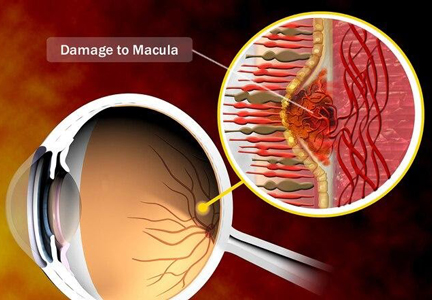
Image courtesy of WebMD
By Linda Conlin, Pro to Pro Managing Editor
An aptamer-based drug for the treatment of AMD has provided the basis for a COVID-19 detecting sensor. In 2004, the FDA approved Macugen (Pegaptanib Sodium) Injection by EyeTech Pharmaceuticals for the treatment of neovascular age-related macular degeneration (wet AMD). Wet AMD is the condition in which abnormal new blood vessels grow in the macula. The newer, weaker blood vessels can leak, causing the macula to bulge or lift, distorting or destroying central vision. Macugen, now a Bausch & Lomb product, inhibits the growth of these new blood vessels.
A protein called VEGF 165 signals the growth of abnormal blood vessels. Macugen uses an aptamer, a single strand of nucleic acid that binds to a specific protein, to bind to VEGF. That in turn blocks the action of VEGF, reducing the growth of the blood vessels and working to control leakage and swelling. Macugen was the first aptamer-based drug FDA approved for therapeutic application.
Inspired by the aptamer technology for Macugen as a therapeutic, Massood Tabib-Azar, a professor at University of Utah electrical and computer engineering, developed a sensor over a year ago to detect the Ziika virus. He will now convert that prototype to a COVID-19 sensor smartphone accessory and device. Pending the outcome of clinical trials in two to three months, anyone with a smartphone, the accessory device and app could test for COVID-19 and receive results in less than 60 seconds.
Here’s how it works. The user would plug the quarter-sized sensor into the cellphone power jack and launch the app made for that device. Then, a drop of saliva, even from coughing or breathing, is placed on the sensor and the result would appear on the screen. Like Macugen’s aptamers that are specific to the VEGF protein, aptamers in the sensor are specific and would only bind with the proteins of COVID-19. If that binding occurs, an electrical resistance would be generated which will be measured in the device, signaling a positive result. The device will be reusable because it can destroy the previous sample using a small electric current to produce heat and remove or disintegrate the virus. Alternatively, the device might use disposable sheets placed on top of the sensor to test saliva, eliminating the need for heat to destroy the previous sample. COVID-19 detection information through the device could also upload to a database, providing critical information about the spread of the disease.
Macugen’s aptamer technology as a treatment, gives hope to AMD patients for preserving their sight. That technology may now give hope to all of us for early, rapid, widespread testing and detection of a deadly virus.
You can learn about age-related eye diseases including AMD and how nutrients can aid in postponing and minimizing their effects with our CE, Nutrition and Vision, at 2020mag.com/ce.











